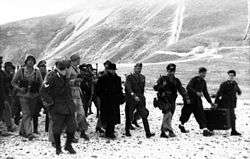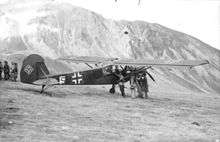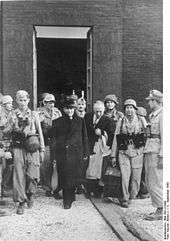Gran Sasso raid
| Operation Oak | |
|---|---|
| Part of World War II | |
 Mussolini rescued by German commandos from his prison in Campo Imperatore on 12 September 1943. | |
| Operational scope | Operational |
| Location | Campo Imperatore, Italy 42°25′34″N 13°31′42″E / 42.42611°N 13.52833°ECoordinates: 42°25′34″N 13°31′42″E / 42.42611°N 13.52833°E |
| Planned | Kurt Student |
| Planned by | Harald Mors |
| Target | Campo Imperatore |
| Date | 12 September 1943 |
| Executed by | Fallschirmjäger-Lehr-Bataillon of the 2. Fallschirmjägerdivision, 1/FJR 7; SS-Sonderverband z.b.V. Friedenthal; Polizia di Stato |
| Outcome | Rescue of Benito Mussolini |
| Casualties | Italian: two killed[1] German: 10 injured |
The Gran Sasso raid refers to Operation Eiche ("Oak"), the rescue of Italian dictator Benito Mussolini by German paratroopers led by Major Otto-Harald Mors and Waffen-SS commandos in September 1943, during World War II. The airborne operation was personally ordered by Adolf Hitler, planned by Harald Mors, and approved by General Kurt Student. Gerhard Mertins was among the paratroopers who participated in the raid.[2]
Overview
On the night between 24 and 25 July 1943, a few weeks after the Allied invasion of Sicily and bombing of Rome, the Italian Grand Council of Fascism voted a motion of no confidence (Ordine del Giorno Grandi) against Mussolini. On the same day, the king replaced him with Marshal Pietro Badoglio[3] and had him arrested.[4]

.jpg)
Mussolini was being transported around Italy by his captors (first to Ponza, then to La Maddalena, both small islands in the Tyrrhenian sea), while Hauptsturmführer (SS captain) Otto Skorzeny—selected personally by Hitler and Ernst Kaltenbrunner to carry out the mission—was tracking him.
Intercepting a coded Italian radio message, Skorzeny used the reconnaissance provided by the agents and informants of SS-Obersturmbannführer Herbert Kappler to determine that Mussolini was being imprisoned at Campo Imperatore Hotel, a ski resort at Campo Imperatore in Italy's Gran Sasso massif, high in the Apennine Mountains. On 12 September 1943, Skorzeny's 26 SS troopers joined the team of 82 Fallschirmjäger to rescue Mussolini in a high-risk glider mission. The commandos landed their dozen DFS 230 gliders on the mountain; only one crashed, causing minor injuries. The Fallschirmjäger and Skorzeny's special troopers then overwhelmed Mussolini's captors (200 well-equipped Carabinieri guards) without a single shot being fired; this was also due to the fact that General Fernando Soleti of the Polizia, who flew in with Skorzeny, told them to stand down or be executed for treason. Skorzeny attacked the radio operator and his equipment, then he formally greeted Mussolini with "Duce, the Führer has sent me to set you free!", to which Mussolini replied "I knew that my friend would not forsake me!"[5]

Mussolini was flown from Campo Imperatore to Vienna, where Mussolini stayed overnight at the Hotel Imperial and was given a hero's welcome. The operation on the ground at Campo Imperatore was in fact led by First Lieutenant Baron Georg Freiherr von Berlepsch, commanded by Major Otto-Harald Mors and under orders from General Kurt Student, all Fallschirmjäger (German air force paratroop) officers; but Skorzeny stewarded the Italian leader first into Rome and eventually into Berlin, right in front of the cameras. After a pro-SS propaganda coup at the behest of Reichsführer-SS Heinrich Himmler and propaganda minister Joseph Goebbels, Skorzeny and his Special Forces (SS-Sonderverband z. b. V. "Friedenthal") of the Waffen-SS were granted the majority of the credit for the operation. The Friedenthaler of the SS-Reichssicherheitshauptamt were for the Waffen-SS what the Brandenburgers were for the Wehrmacht and Abwehr.
Alternative hypotheses
According to some historical researches, based on interviews and contradictions between eyewitnesses and on other documents, the Gran Sasso raid was the possible result of a secret agreement between Badoglio's Italian government and the German government.[6]
Aftermath

The operation granted a rare late-war public relations opportunity to Hermann Göring. Mussolini was made leader of the Italian Social Republic (a German puppet state consisting of the German-occupied portion of Italy). Otto Skorzeny gained a large amount of success from this mission; he received a promotion to Sturmbannführer, the award of the Knight's Cross of the Iron Cross and fame that led to his "most dangerous man in Europe" image. Winston Churchill himself described the mission as "one of great daring".
See also
References
- ↑ Forestry Guard Pasqualino Vitocco and Carabineer Giovanni Natali were shot dead while trying to alert the Campo Imperatore garrison.
- ↑ Romano Mussolini, My father, il Duce, Kales Press 2006, S.29: "For more than sixty years, my father´s liberation from Gran Sasso was attributed solely to Skorzeny, even though Mors and Mertins played crucial roles."
- ↑ Whittam, John (2005). Fascist Italy. Manchester University Press. ISBN 0-7190-4004-3.
- ↑ Annussek, Greg (2005). Hitler's Raid to Save Mussolini. Da Capo Press. ISBN 978-0-306-81396-2.
- ↑ D. G. Williamson (2007). The Age of the Dictators: A Study of the European Dictatorships, 1918-53. Pearson Longman. pp. 440–. ISBN 978-0-582-50580-3.
- ↑ Di Michele, Vincenzo (2015). The Last Secret of Mussolini. Rimini: Il Cerchio. ISBN 978-8884744265.
External links
| Wikimedia Commons has media related to Gran Sasso raid. |